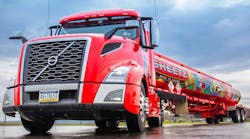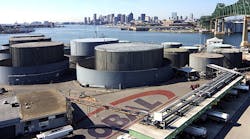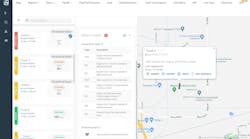The Occupational Safety and Health Administration (OSHA) wants more control over trucking, and the latest focus is on fall protection. Tank fleets, in particular, are being targeted in the current OSHA initiative.
The agency is seeking comments from industry on whether or not it should develop specific regulations to “cover falls from rolling stock and commercial motor vehicles.” The May 24 notice of proposed rulemaking (NPRM) defines motor vehicle to include “tractor-trailer trucks, tank trucks and hopper trucks.” A regulation would cover any employee working more than four feet off the ground.
“This is a proposal that we have to take seriously,” says John Conley, president of National Tank Truck Carriers (NTTC). “OSHA really wants to get more involved in the trucking industry. I just hope that DOT (the Department of Transportation) will object to this intrusion into what is, and should be, its turf. Transportation vehicles present a unique workplace and not one to which OSHA can just apply its standards from other stationary facilities. NTTC will submit comments—which are due August 23—reflecting the views and concerns of our members.”
Conley says OSHA is taking an unusual approach to the fall protection issue. Rather than propose new regulations for commercial vehicles in the 292-page rulemaking, which contains many significant changes to 29CFR Part 1910, it is asking for information on whether there is “a need to propose specific requirements for the protection of employees exposed to falls from rolling stock and motor vehicles.” The agency states in its rulemaking that “If, in response to this issue, OSHA receives sufficient comments and evidence to warrant additional rulemaking, a separate proposed rule will be issued.”
There always has been a bit of a gray area regarding what regulatory authority, if any, OSHA has over trucking equipment, according to Conley. Since its inception, OSHA has tried to get its nose under the trucking tent and into the cab and onto the trailer. OSHA and DOT signed a memorandum of understanding in the 1970s where each agency agreed to not regulate where the other had established jurisdiction. DOT has maintained that it regulates truck equipment but has never addressed fall protection and trailers. OSHA’s directive to its field staff is still to not “cite employee exposure to fall hazards on the tops of rolling stock unless the rolling stock was positioned inside or contiguous to a building where the installation of fall protection is feasible.”
“Make no mistake that OSHA would very much like to propose a regulation on fall protection in this proposed rulemaking, but must have felt it would be challenged as to whether it was the responsible regulatory agency,” Conley says. “The effort to ask questions to determine if such a regulation needs to be written should be viewed as an effort by OSHA to either exercise that authority or to pressure DOT to do so. Remember, OSHA is much emboldened in the Obama Administration, and a power grab makes bureaucratic turf sense.
“Please keep in mind that if you conduct operations in mining facilities or locations that are governed by the National Institute of Occupational Health and Safety (NIOSH), that agency does not have a similar agreement with DOT and does require fall protection equipment for employees who go on top of trailers. Also, the OSHA proposal and request for information does not apply to railroad cars since the Federal Railroad Administration already has jurisdiction over that equipment.”








